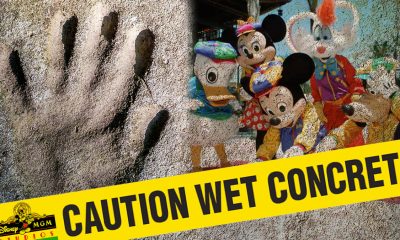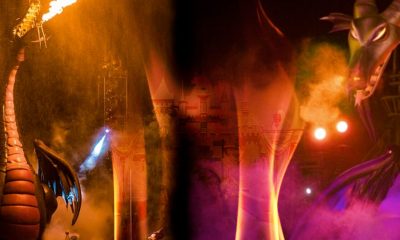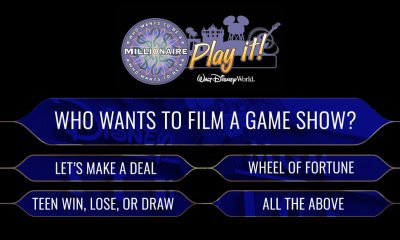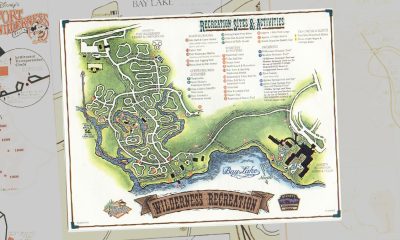History
The Closing of Walt Disney World’s “20,000 Leagues Under the Sea”
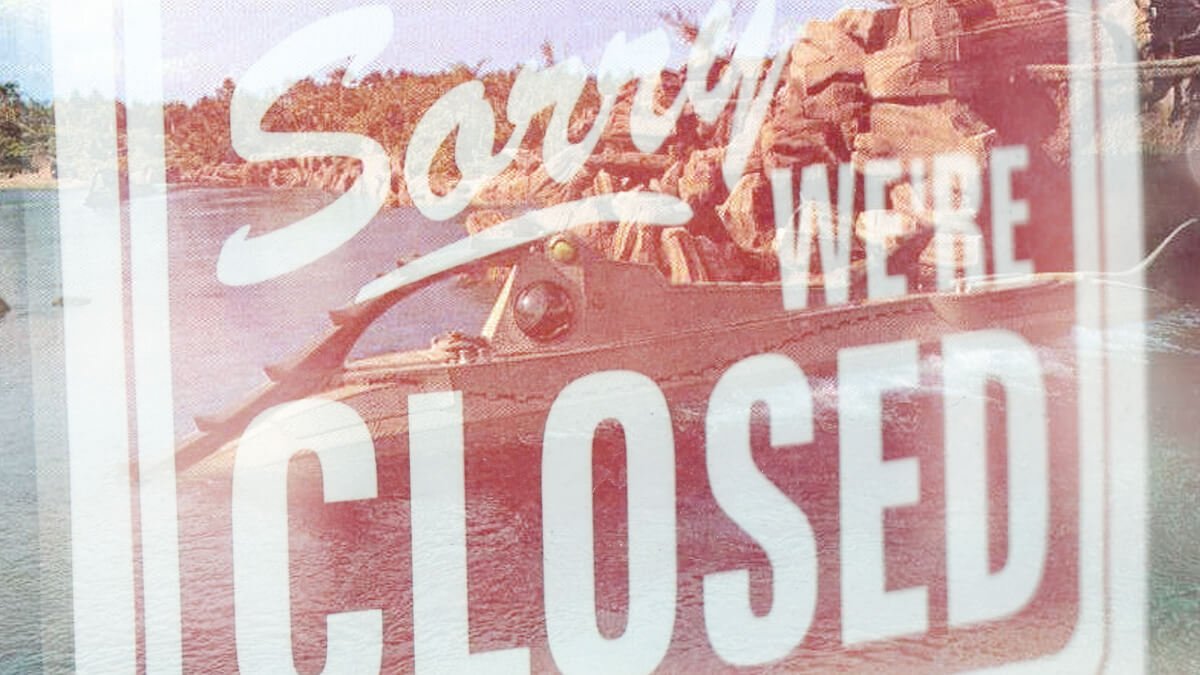
I need help from a Disney World employee. To be specific, someone who used to work at the Magic Kingdom back in the late 1980s / early 1990s.
The reason I’m asking for help is that there used to be this one-page newsletter that that theme park printed & distributed weekly to Cast Members who worked JUST at the Magic Kingdom.
Walt Disney World Cast Member Newsletter Request
I want to stress that this newsletter was different from the Eyes & Ears – which (back then, anyway) was a weekly newspaper (not a newsletter) that the Resort then printed & distributed to ALL Cast Members who worked on property.
This publication – which might have been called Kingdom Cast (Sorry. It’s been almost 30 years now. I’m old after all and I’m now blanking this newsletter’s name) – was typically printed on different colored paper stock every week.
I just need some help here when it comes to recalling the specific name of this newsletter which was primarily intended for Disney World employees who worked at the Magic Kingdom.
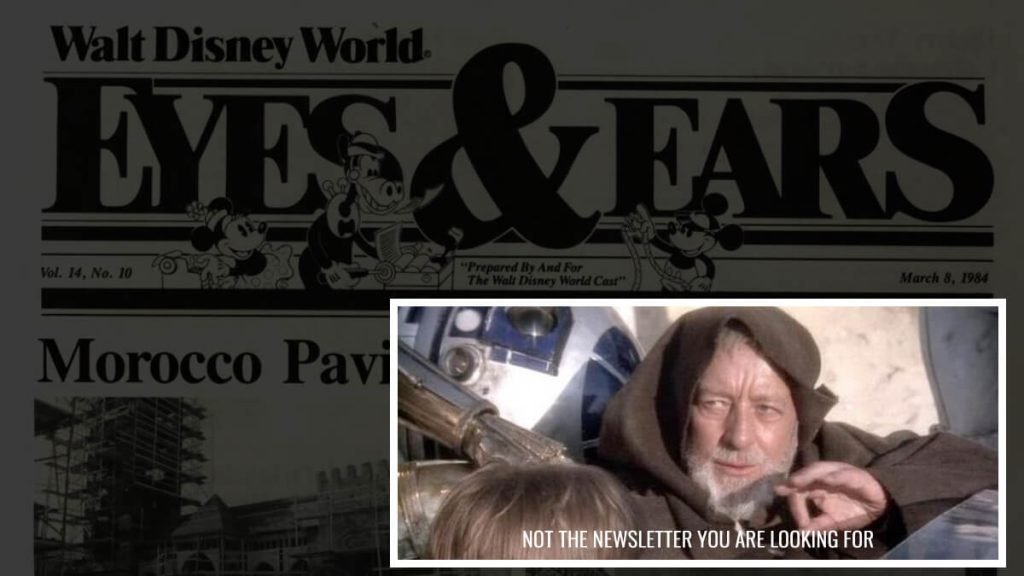
Magic Kingdom Newsletter – August 1994
Anyway … I was living down in Orlando at this time. Where I was trying to make a living writing about The Walt Disney Company. Which was challenging in those pre-Internet days. On the upside, I had lots of friends who worked at the Resort at the time. Who would then slip me copies of all sorts of in-house publications. Which then allowed me to stay on top of what was actually going on on-property.
Anywho … In late August of 1994, I got sent a copy of this particular Magic-Kingdom-only newsletter. Which included a brief item (That I’m recalling from memory now) that said …
… any & all Cast Members who had worked at “20,000 Leagues Under the Seas” over the past 23 years are invited to come by this Fantasyland attraction on the night of Monday, September 5th. We’d like to get together as many current & former 20K employees as possible for a group photo in front of that attraction’s marquee. This image will then be used to commemorate the closing of this Disney World favorite.
This item in that newsletter then went on to say that – after the Magic Kingdom had officially closed for the night – all WDW Cast Members were then welcome to come by the Subs and get in one last ride before “20,000 Leagues” closed for good.
So I immediately realized that this was huge, huge news.
Disney World is closing the Subs at the Magic Kingdom.
And since I was friendly with Leslie Doolittle, the reporter who was wrote the “On Tourism” column for the Orlando Sentinel, I give Leslie a call and read her this item straight out of this Magic Kingdom employee newsletter verbatim. Which Ms. Doolittle then reports in her very next “On Tourism” column. Which then prompts WDW officials to lose their minds.
Initially senior management at the Resort flat-out denies that this Opening Day attraction is actually closing and they demand that the Sentinel immediately print a full retraction. After I provide Ms. Doolittle with a physical copy of this Magic Kingdom employee newsletter and she then shares that with WDW’s PR team … Well, the Resort’s senior management then changes its tune.
They now say … Well, yes. “20,000 Leagues” WILL be closing on September 5, 1994. But what was published in that Magic Kingdom employee newsletter was incorrect. This Fantasyland favorite is NOT closing permanently. But – rather –- 20K will be going down for a lengthy rehab. A REALLY lengthy rehab. The longest ever in this ride’s history.
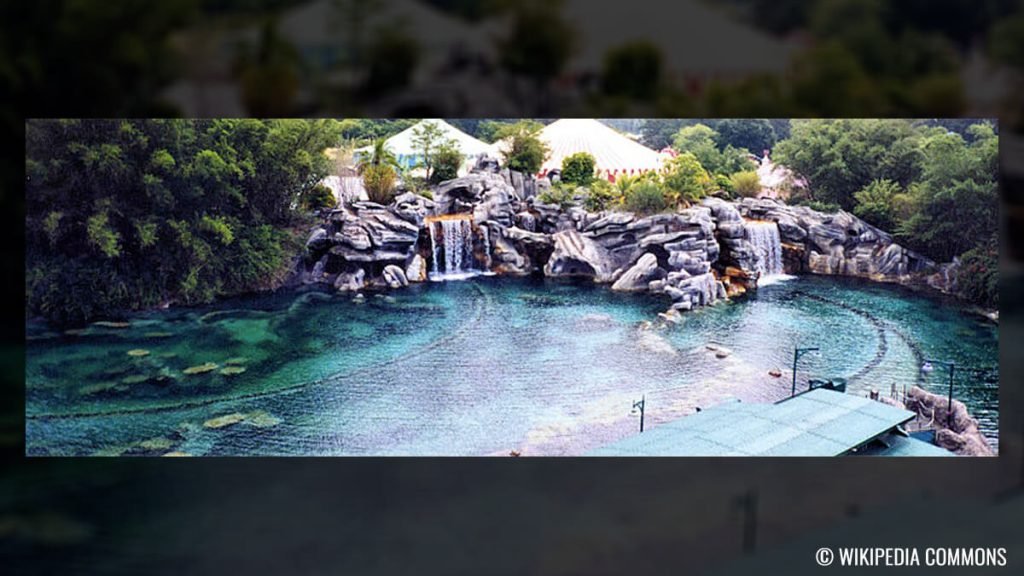
Maintenance Issues with WDW’s “20,000 Leagues Under the Sea”
To explain: Anyone who loved this WDW attraction back in the day will talk about how frustrating it would be back then to visit the Magic Kingdom and then find that “20,000 Leagues” was down for maintenance … again.
Between the harsh Florida sun bleaching the color out of the fake coral & all those plastic fish (which is why – every year – the lagoon had to be drained & dried so these items could then be repainted) not to mention all of the mechanical challenges associated with keeping that fleet of 14 diesel-powered Subs up & running … “20K” was an operational nightmare.
Not to mention being a huge money suck when it came to the Magic Kingdom’s annual operating budget.
So what Disney World senior management said – on the heels of that Orlando Sentinel story — was that “20K” was now closing for a top-to-bottom overhaul. This would be a two year-long project. But the good news was work would be completed in time for WDW’s 25th anniversary celebration. Which was supposed to begin in October of 1996.
Which – I have to tell you – wasn’t the truth at all.
That Magic Kingdom employee only newsletter had actually gotten everything right. Disney World’s “20,000 Leagues” ride WAS closing for good on September 4, 1994. But not for the reason you might think.
Euro Disney Financial Troubles
Euro Disney had opened back in April of 1992. The park itself did well, attendance-wise. Not so much when it came to those 6 on-site hotels. Weighed down by enormous debt, Eisner actually talked about closing the place down in December of 1993 unless a new financial arrangement could be worked out with the 30+ banks that had originally funded construction of this $4.4 billion resort. A deal was reached in the late Winter / early Spring of 1994. But one of the conditions of this deal is that The Walt Disney Company would suspend the collection of any royalty payments that the Company was due from the Euro Disney Project from 1994 through 1998.
This new agreement / financial restructuring may have saved Euro Disney (which then got rebranded / relaunched as the Disneyland Paris Resort). But it also choked off a huge revenue stream at The Walt Disney Company. Which is why word then came down from on high that ALL divisions at the Mouse House now needed to tighten their belts. Economize.
And down at Walt Disney World … Well, managers then saw this edict as an opportunity to finally pull the plug on the Magic Kingdom’s expensive-to-maintain / difficult-to-operate “20,000 Leagues” ride. And the beauty part was … This wasn’t their fault. They were just following Corporate’s orders.
Fan Backlash for “20,000 Leagues” Closing Announcement
What Walt Disney World senior management hadn’t anticipated was – on the heels of Leslie Doolittle’s story about how “20K” would be closing – that the Resort would then be flooded with letters begging Magic Kingdom managers to change their minds. Save this opening day attraction.
Which – again – brings us back to that “The-Subs-will-be-back-up-and-running-by-1996-just-in-time-for-WDW’s-25th-anniversary” story. Which – I’ll again remind you – just wasn’t true. This was a lie that the Company quickly put out there to deflect & divert from what quickly had become a PR nightmare for the Magic Kingdom.
Michael Ovitz – Save or Close “20k Leagues”
So okay. We now jump ahead to August of 1995. Which is when Michael Ovitz – previously the head of CAA and once rumored to be the most powerful man in Hollywood – becomes the President of The Walt Disney Company. Michael Eisner hires Ovitz to be his new second-in-command (Following the tragic death of Frank Wells back in April of 1994).
And Ovitz … He wants to hit the ground running. Prove to Eisner that he’s now going to be an extremely valuable member of the Disney team.
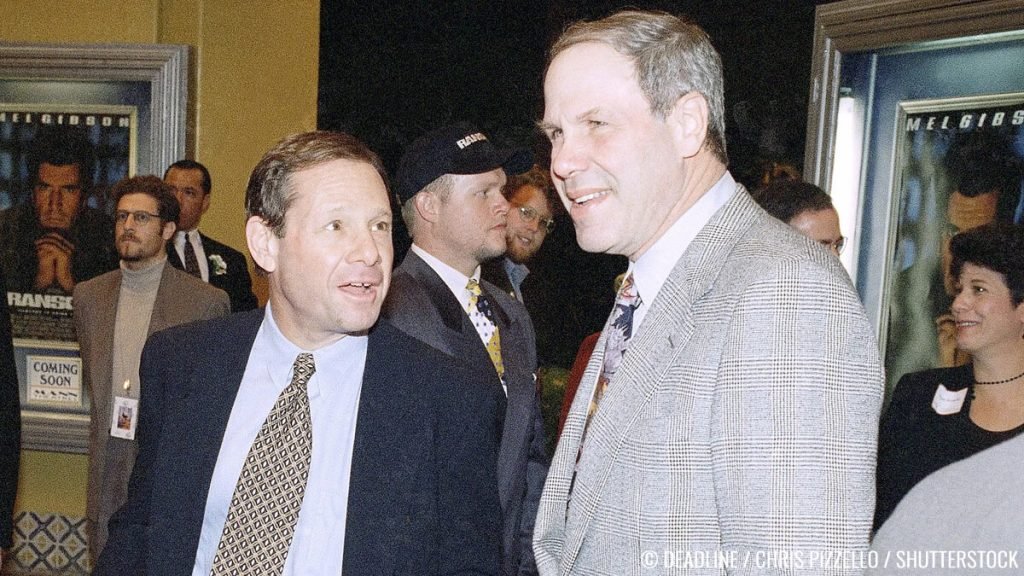
So picture this. It’s now September of 1995. And Michael Ovitz – because he wants to learn about every aspect of The Walt Disney Company – is now on a familiarization tour of the entire corporation. And one of his very first stops is The Walt Disney World Resort.
And Michael (Ovitz, not Eisner) is a very data-driven guy. And he knows about the now-thousands of letters & phone calls that the Walt Disney World Resort has received about “20,000 Leagues Under the Sea.” Which – again (remember) – WDW managers have been saying publicly is only temporarily closed. At this point, they’re still insisting that that this Opening Day Attraction will be back up & running in time for WDW’s 25th anniversary. Which is supposed to start on October 1, 1996.
So Ovitz – once he arrives on WDW property says – “Hey, I’ve heard about the Magic Kingdom’s 20K problem. And I’d like to personally check out that ride while I’m down here in Florida. Maybe once I see it, I can then make some recommendations. Perhaps help speed along the funding you need to get that ride up & running again.”
And seeing as Michael Ovitz is the newly installed second-in-command at the Mouse House, WDW senior management – after they hear this request – says “Sure. Absolutely. We’d love to do that, Mr. Ovitz. We’ll come by your hotel first thing tomorrow morning and take you straight over to the Magic Kingdom before that park opens to the public. That way, you can see for yourself the challenges that we’re now facing with bringing this Fantasyland ride back up online in time for Disney World’s 25th anniversary celebration. We’d LOVE to hear your recommendations.”
Which is why — the following morning at 7 a.m. — Mike Ovitz found himself standing in the queue at “20,000 Leagues Under the Sea” as a sub that was loudly belching smoke came rumbling up to the dock. The Disney Company’s brand-new President then climbed down the stairs and found a quarter inch of water sloshing around in the bottom of the boat. When Mike pointed this out, a WDW ops staffer said “Well, you have to understand that a lot of our subs are over 20 years old, Mr. Ovitz. So many of them have developed small pinhole leaks over time.”
The sub then lurched away from the dock and took Ovitz & the ops crew on a somewhat jerky trip around the “20K” ride track, with the attraction’s soundtrack barely audible through the ship’s crackling loudspeakers.
As you might imagine, once the boat pulled up to the dock, Michael quickly climbed out of the mildewed interior. He then turned to WDW’s ops staff and then asked what it would cost to bring “20K” back online. Ovitz was then quoted a number that was reportedly more than the Resort was planning on spending on its entire year-long 25th anniversary celebration.
Ovitz knew that a redo of the Subs that was going to be that expensive would be a non-started with Eisner. Especially at that time in the Company’s history, where – on the heels of the Euro Disney debt reorg and Disney deferring any royalty payments they were supposed to take out of that Resort ‘til 1998 – word was coming down from on high to every division at Disney to economize & cut back.
Ovitz wanted to show Eisner that – as The Walt Disney Company’s new president – that he could make the tough calls. So after hearing how much it would supposedly now cost the WDW Resort to bring the Subs back online, Ovitz then supposedy said “Well, maybe we’d just better cancel this rehab project and close 20K for good.” And those WDW managers standing with Ovitz in the Subs Load / Unload area then said “Oh, no. Really? Are you sure?”
Not Reopening by Summer – 20,000 Leagues “Delayed”
Which is why – in the early part of 1996. Just a few months after Michael Ovitz visited the Walt Disney World Resort on that fam trip — Bruce Laval, who was (at that time, anyway) the Resort’s Vice President for Operations – did an interview with the Sentinel. Where Bruce told Leslie Doolittle that …
“We were originally pursuing a short-term strategy with 20K. Something would have then allowed us to reopen the Subs with minor enhancements. But we found that there was no way we could accomplish that by this Summer.”
Now please note that what Bruce is saying in early 1996 is very different from what the Resort had been putting out back in the Fall of 1994. Back then, the Magic Kingdom was going to shut down “20K” for a nearly two-year-long, top-to-bottom redo so that this Fantasyland attraction could then be part of WDW’s 25th anniversary celebration looking bigger & better from ever. But come April of 1996, that story has significantly changed. The Park was now looking to re-open the Subs with “minor enhancements.” But even that would be impossible for the Resort to now pull off by the Summer of 1996.
Which bring us to what Laval next told the Sentinel:
“We are abandoning those plans for the Subs and are now exploring other long term options.”
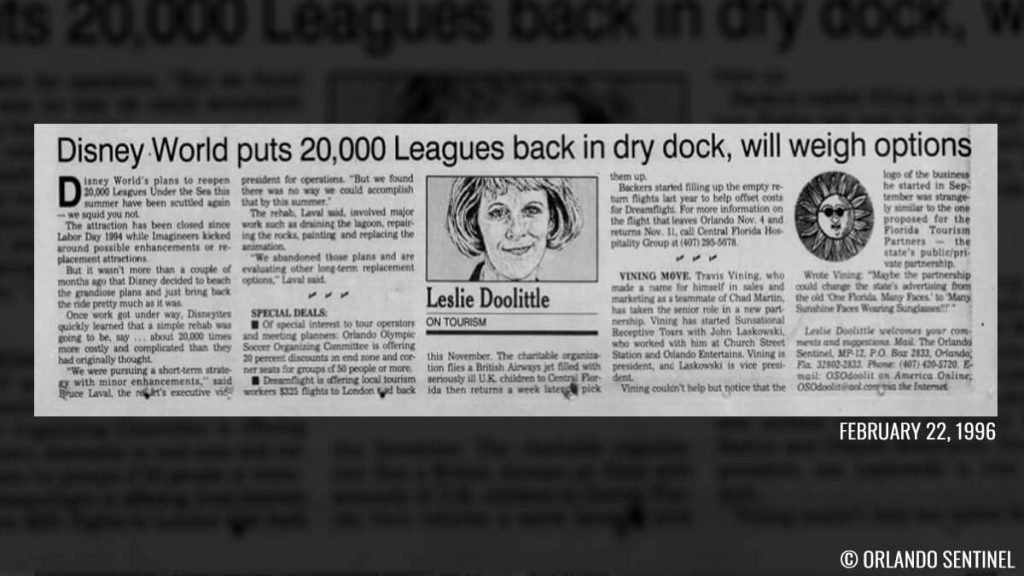
So would it surprise you to learn that – in the middle of all the hoopla associated with the officially launch of WDW’s 25th anniversary celebration in October of 1996 – Disney World’s PR very quietly realizes the news that 20K is now closed permanently. That – on the recommendation of Michael Ovitz, the president of The Walt Disney Company — the Magic Kingdom is now abandoning any plans to rehab / revitalize that attraction.
Poor Guest Experience for Michael Ovitz
You wanna know the kicker to this story. Those WDW managers – when they brought Michael Ovitz into the Magic Kingdom early that September morning back in 1995 – had totally sandbagged the new president of The Walt Disney Company.
To make sure that Ovitz had the worst possible ride experience that morning …
Well, out of the fleet of 14 subs that had been built for this Fantasyland attraction, those managers deliberately picked the one that was in the worst possible shape.
They then recruited a veteran ride operator and quietly gave this Cast Member the expressed instructions to “Give Ovitz the roughest ride possible.”
Then – to seal the deal — they threw a couple of buckets of water down into the bottom of that Sub to simulate a pinhole leak.
And all of this was done to give Ovitz the impression that WDW’s subs were now beyond salvaging.
The real irony here is that Michael Ovitz, the man who made the permanent closure of the Subs at WDW’s Magic Kingdom possible because he fell for the elaborate ruse that those Disney World managers staged back in September of 1995 … wasn’t all that long-lived at the Mouse House.
Eisner fired Ovitz in December of 1996 (just 15 months after he’d taken the job) largely because Eisner felt that Ovitz just wasn’t a good fit at Disney.
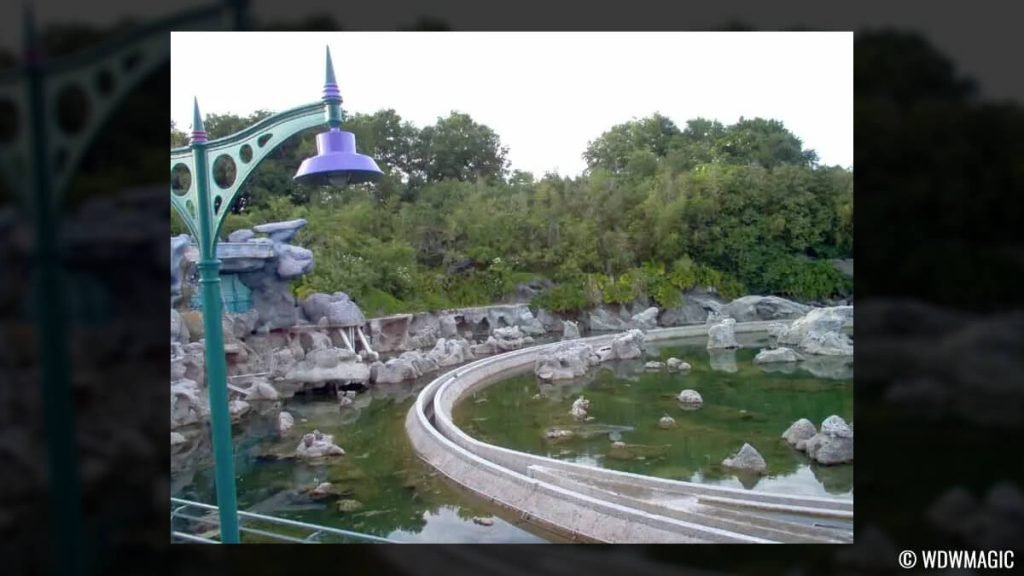
I have to tell you that WDW managers were thrilled that Ovitz was on the job at Disney for as long as he was. For – in September of 1995 — he made it possible to do what they couldn’t. Which was close the Subs for good. Which then left that huge chunk of Fantasyland open for redevelopment.
Mind you, it would take nearly another 13 years (from when the WDW Resort finally officially announced that the Subs at the Magic Kingdom were closed in October of 1996 ‘til the first D23 Expo back in September of 2009. Which was when the WDW Resort officially confirmed that the long-rumored expansion of the Magic Kingdom’s Fantasyland section was in the works) before that redevelopment effort would then move forward. But as anyone who’s been watching the construction of “TRON Lightcycle Run” limp along at the Magic Kingdom these past five years, things move slowly these days at the Magic Kingdom.

And – speaking of the Magic Kingdom – if anyone who worked at that theme park back in the late 1980s / early 1990s could please get back to me about that newsletter-for-Cast-Members-who-worked-specifically-at-that-Park (I’m 90% certain this weekly newsletter was called Kingdom Cast. But – again – I could be wrong), I’d really appreciate it.
This article is based on research for The Disney Dish Podcast “Episode 390”, published on September 5, 2022. The Disney Dish Podcast is part of the Jim Hill Media Podcast Network.
History
The Evolution and History of Mickey’s ToonTown

Disneyland in Anaheim, California, holds a special place in the hearts of Disney fans worldwide, I mean heck, it’s where the magic began after all. Over the years it’s become a place that people visit in search of memorable experiences. One fan favorite area of the park is Mickey’s Toontown, a unique land that lets guests step right into the colorful, “Toony” world of Disney animation. With the recent reimagining of the land and the introduction of Micky and Minnies Runaway Railway, have you ever wondered how this land came to be?
There is a fascinating backstory of how Mickey’s Toontown came into existence. It’s a tale of strategic vision, the influence of Disney executives, and a commitment to meeting the needs of Disney’s valued guests.
The Beginning: Mickey’s Birthdayland
The story of Mickey’s Toontown starts with Mickey’s Birthdayland at Walt Disney World’s Magic Kingdom. Opened in 1988 to celebrate Mickey Mouse’s 60th birthday, this temporary attraction was met with such overwhelming popularity that it inspired Disney executives to think bigger. The idea was to create a permanent, immersive land where guests could step into the animated world of Mickey Mouse and his friends.
In the early ’90s, Disneyland was in need of a refresh. Michael Eisner, the visionary leader of The Walt Disney Company at the time, had an audacious idea: create a brand-new land in Disneyland that would celebrate Disney characters in a whole new way. This was the birth of Mickey’s Toontown.
Initially, Disney’s creative minds toyed with various concepts, including the idea of crafting a 100-Acre Woods or a land inspired by the Muppets. However, the turning point came when they considered the success of “Who Framed Roger Rabbit.” This film’s popularity and the desire to capitalize on contemporary trends set the stage for Toontown’s creation.
From Concept to Reality: The Birth of Toontown
In 1993, Mickey’s Toontown opened its gates at Disneyland, marking the first time in Disney Park history where guests could experience a fully realized, three-dimensional world of animation. This new land was not just a collection of attractions but a living, breathing community where Disney characters “lived,” worked, and played.
Building Challenges: Innovative Solutions
The design of Mickey’s Toontown broke new ground in theme park aesthetics. Imagineers were tasked with bringing the two-dimensional world of cartoons into a three-dimensional space. This led to the creation of over 2000 custom-built props and structures that embodied the ‘squash and stretch’ principle of animation, giving Toontown its distinctiveness.
And then there was also the challenge of hiding the Team Disney Anaheim building, which bore a striking resemblance to a giant hotdog. The Imagineers had to think creatively, using balloon tests and imaginative landscaping to seamlessly integrate Toontown into the larger park.

Key Attractions: Bringing Animation to Life
Mickey’s Toontown featured several groundbreaking attractions. “Roger Rabbit’s Car Toon Spin,” inspired by the movie “Who Framed Roger Rabbit,” became a staple of Toontown, offering an innovative ride experience. Gadget’s Go-Coaster, though initially conceived as a Rescue Rangers-themed ride, became a hit with younger visitors, proving that innovative design could create memorable experiences for all ages.
Another crown jewel of Toontown is Mickey’s House, a walkthrough attraction that allowed guests to explore the home of Mickey Mouse himself. This attraction was more than just a house; it was a carefully crafted piece of Disney lore. The house was designed in the American Craftsman style, reflecting the era when Mickey would have theoretically purchased his first home in Hollywood. The attention to detail was meticulous, with over 2000 hand-crafted, custom-built props, ensuring that every corner of the house was brimming with character and charm. Interestingly, the design of Mickey’s House was inspired by a real home in Wichita Falls, making it a unique blend of real-world inspiration and Disney magic.
Mickey’s House also showcased Disney’s commitment to creating interactive and engaging experiences. Guests could make themselves at home, sitting in Mickey’s chair, listening to the radio, and exploring the many mementos and references to Mickey’s animated adventures throughout the years. This approach to attraction design – where storytelling and interactivity merged seamlessly – was a defining characteristic of ToonTown’s success.

Executive Decisions: Shaping ToonTown’s Unique Attractions
The development of Mickey’s Toontown wasn’t just about creative imagination; it was significantly influenced by strategic decisions from Disney executives. One notable input came from Jeffrey Katzenberg, who suggested incorporating a Rescue Rangers-themed ride. This idea was a reflection of the broader Disney strategy to integrate popular contemporary characters and themes into the park, ensuring that the attractions remained relevant and engaging for visitors.
In addition to Katzenberg’s influence, Frank Wells, the then-President of The Walt Disney Company, played a key role in the strategic launch of Toontown’s attractions. His decision to delay the opening of “Roger Rabbit’s Car Toon Spin” until a year after Toontown’s debut was a calculated move. It was designed to maintain public interest in the park by offering new experiences over time, thereby giving guests more reasons to return to Disneyland.
These executive decisions highlight the careful planning and foresight that went into making Toontown a dynamic and continuously appealing part of Disneyland. By integrating current trends and strategically planning the rollout of attractions, Disney executives ensured that Toontown would not only capture the hearts of visitors upon its opening but would continue to draw them back for new experiences in the years to follow.
Global Influence: Toontown’s Worldwide Appeal
The concept of Mickey’s Toontown resonated so strongly that it was replicated at Tokyo Disneyland and influenced elements in Disneyland Paris and Hong Kong Disneyland. Each park’s version of Toontown maintained the core essence of the original while adapting to its cultural and logistical environment.
Evolution and Reimagining: Toontown Today
As we approach the present day, Mickey’s Toontown has recently undergone a significant reimagining to welcome “Mickey & Minnie’s Runaway Railway” in 2023. This refurbishment aimed to enhance the land’s interactivity and appeal to a new generation of Disney fans, all while retaining the charm that has made ToonTown a beloved destination for nearly three decades.

Dive Deeper into ToonTown’s Story
Want to know more about Mickey’s Toontown and hear some fascinating behind-the-scenes stories, then check out the latest episode of Disney Unpacked on Patreon @JimHillMedia. In this episode, the main Imagineer who worked on the Toontown project shares lots of interesting stories and details that you can’t find anywhere else. It’s full of great information and fun facts, so be sure to give it a listen!
History
Unpacking the History of the Pixar Place Hotel

Pixar Place Hotel, the newly unveiled 15-story tower at the Disneyland Resort, has been making waves in the Disney community. With its unique Pixar-themed design, it promises to be a favorite among visitors.
However, before we delve into this exciting addition to the Disneyland Resort, let’s take a look at the fascinating history of this remarkable hotel.
The Emergence of the Disneyland Hotel
To truly appreciate the story of the Pixar Place Hotel, we must turn back the clock to the early days of Disneyland. While Walt Disney had the visionary ideas and funding to create the iconic theme park, he faced a challenge when it came to providing accommodations for the park’s visitors. This is where his friend Jack Wrather enters the picture.
Jack Wrather, a fellow pioneer in the television industry, stepped in to assist Walt Disney in realizing his dream. Thanks to the success of the “Lassie” TV show produced by Wrather’s company, he had the financial means to build a hotel right across from Disneyland.
The result was the Disneyland Hotel, which opened its doors in October 1955. Interestingly, the early incarnation of this hotel had more of a motel feel than a hotel, with two-story buildings reminiscent of the roadside motels popular during the 1950s. The initial Disneyland Hotel consisted of modest structures that catered to visitors looking for affordable lodging close to the park. While the rooms were basic, it marked the beginning of something extraordinary.
The Evolution: From Emerald of Anaheim to Paradise Pier
As Disneyland’s popularity continued to soar, so did the demand for expansion and improved accommodations. In 1962, the addition of an 11-story tower transformed the Disneyland Hotel, marking a significant transition from a motel to a full-fledged hotel.
The addition of the 11-story tower elevated the Disneyland Hotel into a more prominent presence on the Anaheim skyline. At the time, it was the tallest structure in all of Orange County. The hotel’s prime location across from Disneyland made it an ideal choice for visitors. With the introduction of the monorail linking the park and the hotel, accessibility became even more convenient. Unique features like the Japanese-themed reflecting pools added to the hotel’s charm, reflecting a cultural influence that extended beyond Disney’s borders.
Japanese Tourism and Its Impact
During the 1960s and 1970s, Disneyland was attracting visitors from all corners of the world, including Japan. A significant number of Japanese tourists flocked to Anaheim to experience Walt Disney’s creation. To cater to this growing market, it wasn’t just the Disneyland Hotel that aimed to capture the attention of Japanese tourists. The Japanese Village in Buena Park, inspired by a similar attraction in Nara, Japan, was another significant spot.
These attractions sought to provide a taste of Japanese culture and hospitality, showcasing elements like tea ceremonies and beautiful ponds with rare carp and black swans. However, the Japanese Village closed its doors in 1975, likely due to the highly competitive nature of the Southern California tourist market.
The Emergence of the Emerald of Anaheim
With the surge in Japanese tourism, an opportunity arose—the construction of the Emerald of Anaheim, later known as the Disneyland Pacific Hotel. In May 1984, this 15-story hotel opened its doors.
What made the Emerald unique was its ownership. It was built not by The Walt Disney Company or the Oriental Land Company (which operated Tokyo Disneyland) but by the Tokyu Group. This group of Japanese businessmen already had a pair of hotels in Hawaii and saw potential in Anaheim’s proximity to Disneyland. Thus, they decided to embark on this new venture, specifically designed to cater to Japanese tourists looking to experience Southern California.
Financial Challenges and a Changing Landscape
The late 1980s brought about two significant financial crises in Japan—the crash of the NIKKEI stock market and the collapse of the Japanese real estate market. These crises had far-reaching effects, causing Japanese tourists to postpone or cancel their trips to the United States. As a result, reservations at the Emerald of Anaheim dwindled.
To adapt to these challenging times, the Tokyu Group merged the Emerald brand with its Pacific hotel chain, attempting to weather the storm. However, the financial turmoil took its toll on the Emerald, and changes were imminent.
The Transition to the Disneyland Pacific Hotel
In 1995, The Walt Disney Company took a significant step by purchasing the hotel formerly known as the Emerald of Anaheim for $35 million. This acquisition marked a change in the hotel’s fortunes. With Disney now in control, the hotel underwent a name change, becoming the Disneyland Pacific Hotel.
Transformation to Paradise Pier
The next phase of transformation occurred when Disney decided to rebrand the hotel as Paradise Pier Hotel. This decision aligned with Disney’s broader vision for the Disneyland Resort.
While the structural changes were limited, the hotel underwent a significant cosmetic makeover. Its exterior was painted to complement the color scheme of Paradise Pier, and wave-shaped crenellations adorned the rooftop, creating an illusion of seaside charm. This transformation was Disney’s attempt to seamlessly integrate the hotel into the Paradise Pier theme of Disney’s California Adventure Park.
Looking Beyond Paradise Pier: The Shift to Pixar Place
In 2018, Disneyland Resort rebranded Paradise Pier as Pixar Pier, a thematic area dedicated to celebrating the beloved characters and stories from Pixar Animation Studios. As a part of this transition, it became evident that the hotel formally known as the Disneyland Pacific Hotel could no longer maintain its Paradise Pier theme.
With Pixar Pier in full swing and two successful Pixar-themed hotels (Toy Story Hotels in Shanghai Disneyland and Tokyo Disneyland), Disney decided to embark on a new venture—a hotel that would celebrate the vast world of Pixar. The result is Pixar Place Hotel, a 15-story tower that embraces the characters and stories from multiple Pixar movies and shorts. This fully Pixar-themed hotel is a first of its kind in the United States.
The Future of Pixar Place and Disneyland Resort
As we look ahead to the future, the Disneyland Resort continues to evolve. The recent news of a proposed $1.9 billion expansion as part of the Disneyland Forward project indicates that the area surrounding Pixar Place is expected to see further changes. Disneyland’s rich history and innovative spirit continue to shape its destiny.
In conclusion, the history of the Pixar Place Hotel is a testament to the ever-changing landscape of Disneyland Resort. From its humble beginnings as the Disneyland Hotel to its transformation into the fully Pixar-themed Pixar Place Hotel, this establishment has undergone several iterations. As Disneyland Resort continues to grow and adapt, we can only imagine what exciting developments lie ahead for this iconic destination.
If you want to hear more stories about the History of the Pixar Place hotel, check our special edition of Disney Unpacked over on YouTube.
Stay tuned for more updates and developments as we continue to explore the fascinating world of Disney, one story at a time.
History
From Birthday Wishes to Toontown Dreams: How Toontown Came to Be

In the latest release of Episode 4 of Disney Unpacked, Len and I return, joined as always by Disney Imagineering legend, Jim Shull. This two-part episode covers all things Mickey’s Birthday Land and how it ultimately led to the inspiration behind Disneyland’s fan-favorite land, “Toontown”. But let’s not get ahead of ourselves here. It all starts in the early days at Disneyland.
Early Challenges in Meeting Mickey
Picture this: it’s the late 1970s and early 1980s, and you’re at Disneyland. You want to meet the one and only Mickey Mouse, but there’s no clear way to make it happen. You rely on Character Guides, those daily printed sheets that point you in Mickey’s general direction. But let’s be honest, it was like finding a needle in a haystack. Sometimes, you got lucky; other times, not so much.

Mickey’s Birthdayland: A Birthday Wish that Came True
Fast forward to the late 1980s. Disney World faced a big challenge. The Disney-MGM Studios Theme Park was under construction, with the company’s marketing machine in full swing, hyping up the opening of Walt Disney World’s third theme park, MGM Studios, in the Spring of 1989. This extensive marketing meant that many people were opting to postpone their family’s next trip to Walt Disney World until the following year. Walt Disney World needed something compelling to motivate guests to visit Florida in 1988, the year before Disney MGM Studios opened.
Enter stage left, Mickey’s Birthdayland. For the first time ever, an entire land was dedicated to a single character – and not just any character, but the mouse who started it all. Meeting Mickey was no longer a game of chance; it was practically guaranteed.

The Birth of Birthdayland: Creative Brilliance Meets Practicality
In this episode, we dissect the birth of Mickey’s Birthdayland, an initiative that went beyond celebrating a birthday. It was a calculated move, driven by guest feedback and a need to address issues dating back to 1971. Imagineers faced the monumental task of designing an experience that honored Mickey while efficiently managing the crowds. This required the perfect blend of creative flair and logistical prowess – a hallmark of Disney’s approach to theme park design.
Evolution: From Birthdayland to Toontown
The success of Mickey’s Birthdayland was a real game-changer, setting the stage for the birth of Toontown – an entire land that elevated character-centric areas to monumental new heights. Toontown wasn’t merely a spot to meet characters; it was an immersive experience that brought Disney animation to life. In the episode, we explore its innovative designs, playful architecture, and how every nook and cranny tells a story.

Impact on Disney Parks and Guests
Mickey’s Birthdayland and Toontown didn’t just reshape the physical landscape of Disney parks; they transformed the very essence of the guest experience. These lands introduced groundbreaking ways for visitors to connect with their beloved characters, making their Disney vacations even more unforgettable.
Beyond Attractions: A Cultural Influence
But the influence of these lands goes beyond mere attractions. Our episode delves into how Mickey’s Birthdayland and Toontown left an indelible mark on Disney’s culture, reflecting the company’s relentless dedication to innovation and guest satisfaction. It’s a journey into how a single idea can grow into a cherished cornerstone of the Disney Park experience.

Unwrapping the Full Story of Mickey’s Birthdayland
Our two-part episode of Disney Unpacked is available for your viewing pleasure on our Patreon page. And for those seeking a quicker Disney fix, we’ve got a condensed version waiting for you on our YouTube channel. Thank you for being a part of our Disney Unpacked community. Stay tuned for more episodes as we continue to “Unpack” the fascinating world of Disney, one story at a time.
-

 History10 months ago
History10 months agoThe Evolution and History of Mickey’s ToonTown
-

 History11 months ago
History11 months agoUnpacking the History of the Pixar Place Hotel
-

 History11 months ago
History11 months agoFrom Birthday Wishes to Toontown Dreams: How Toontown Came to Be
-

 Film & Movies8 months ago
Film & Movies8 months agoHow Disney’s “Bambi” led to the creation of Smokey Bear
-

 News & Press Releases10 months ago
News & Press Releases10 months agoNew Updates and Exclusive Content from Jim Hill Media: Disney, Universal, and More
-

 Merchandise8 months ago
Merchandise8 months agoIntroducing “I Want That Too” – The Ultimate Disney Merchandise Podcast
-

 Theme Parks & Themed Entertainment3 months ago
Theme Parks & Themed Entertainment3 months agoDisney’s Forgotten Halloween Event: The Original Little Monsters on Main Street
-

 Film & Movies3 months ago
Film & Movies3 months agoHow “An American Tail” Led to Disney’s “Hocus Pocus”



